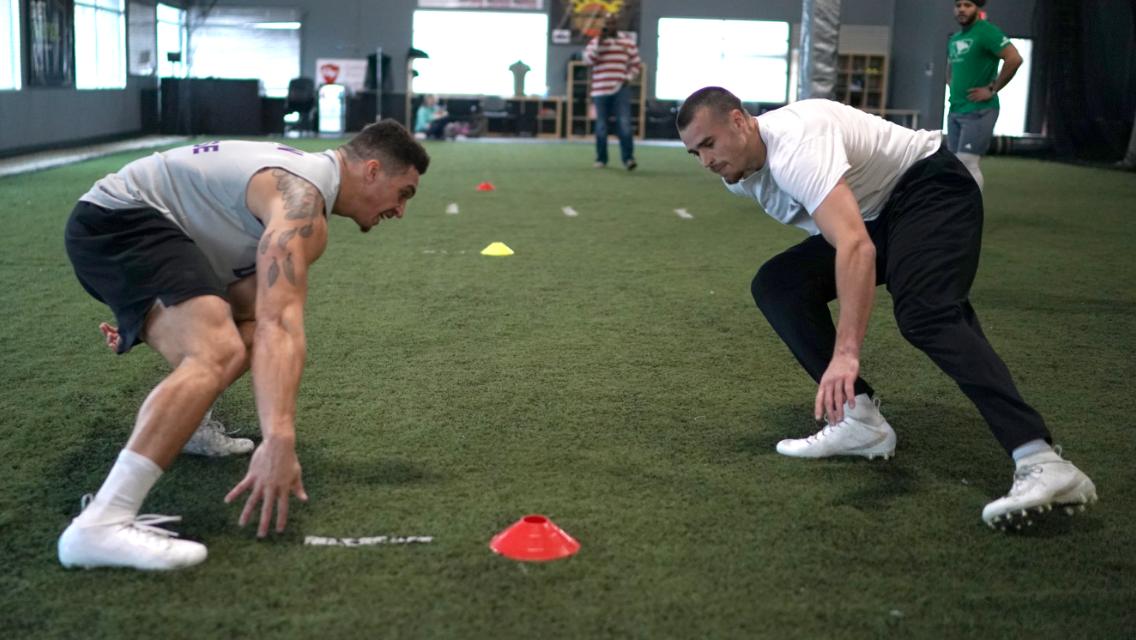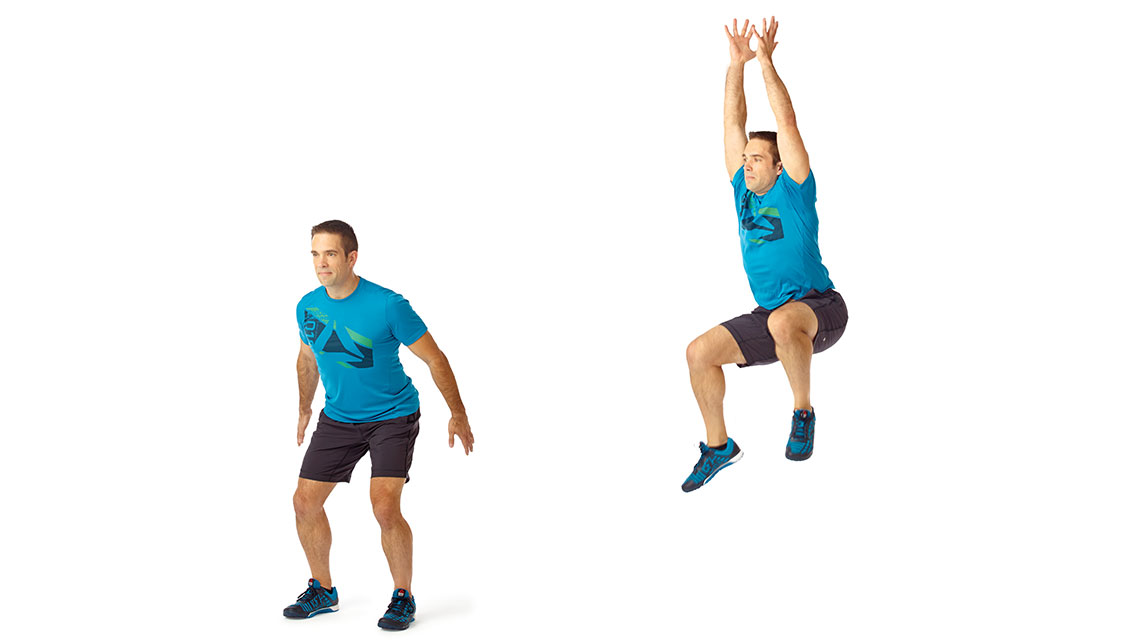Whether your relationship with football includes regular games on the field, setting your weekly fantasy lineup, or simply enjoying the snacks that accompany football Sunday, you can find benefit and enjoyment from this workout.
“Workouts designed for football players place a primary focus on strength, power, and speed,” says DeVentri Jordan, founder and national director of GameFace Training. “No matter if you’re a football player or not, you’ll exercise your entire body and add a burst of explosiveness when you include these movements in your workout.”
Jordan designed this workout with people of all levels and abilities in mind. Channel your inner athlete and give this routine a try. And if you or your child happens to be a player, regularly incorporate the moves into your training to improve your skills.
The Workout
Dynamic Warm-Up
“Football is a sport that requires all planes of movement — front, back, and side-to-side,” says Jordan. “Therefore, during the warm-up, we want to be sure we’re taking the body through all of those planes.”
Before completing the following moves, Jordan suggests spending a few minutes stretching or foam rolling to help loosen up your body.
High-Knee Runs
Complete four times for 10 yards each.
- Set up a start and a finish line that are 10 yards (30 feet) apart.
- Stand tall, facing forward, with your feet shoulder width apart.
- Like a regular run, begin by driving your right knee up in coordination with your left arm, immediately followed by your left knee and right arm. Rapidly fire your knees up toward your chest as fast as possible while moving forward toward the 10-yard mark.
- Attempt to get your knees higher and speed faster with each rep. Rest for one minute between each set.
Side Shuffles
Complete four times for 10 yards each.
- Set up a start and a finish line that are 10 yards (30 feet) apart.
- Stand sideways with your feet slightly wider than shoulder width, your knees bent into a one-quarter-squat position, and your chest and eyes up.
- While staying low and maintaining the starting position, begin to shuffle toward the 10-yard mark. Maintain wide feet throughout and do not allow your heels to click together or feet to crossover.
- Repeat facing the other direction. Complete two repetitions with your right foot leading and two with your left foot leading. Rest for one minute between each set.
Back Pedals
Complete four times for 10 yards each.
- Set up a start and a finish line that are 10 yards (30 feet) apart.
- Stand with your back facing the finish line and your feet shoulder width apart. Bend your knees and let your body lean forward slightly so your chest is over your toes; keep your eyes up.
- While maintaining the starting position, pedal backward for the length of the 10 yards by pushing the balls of your feet through the ground.
- Rest for 45 seconds between each set.
The Explosive Power Block
“Power is essential for enhancing acceleration by triggering fast-twitch fibers within the muscle,” says Jordan. “There are many ways — both on the field and in the weight room — to accomplish this. As a beginner, it’s best to start with foundational jumps.”
While completing these moves, aim for maximum effort. You want every jump to be as high or as far as you can possibly go.
Vertical Jumps
Complete four jumps, resetting your feet before each jump, then rest for one minute. Repeat for a total of four sets. (Note: If you’re doing this indoors, make sure the ceiling is high enough for you to jump without hitting your hands or head.)
- Stand tall with your feet shoulder width apart.
- Reach your hands straight up toward the sky while coming up onto your toes.
- Quickly drop into a squat position while throwing your hands down and back.
- Explode up by jumping as high as you can and reaching your hands up toward the sky. Important note: Jump for height here!
- Land as softly and quietly as you can, aiming to land in the same position you were in before you jumped (step three).
Broad Jumps
Complete four jumps, resetting your feet before each jump, then rest for one minute. Repeat for a total of four sets.
- Stand tall with your feet shoulder width apart.
- Reach your hands straight up toward the sky while coming up onto your toes.
- Quickly drop into a squat position while driving your hands down and back.
- Explode forward by jumping as far as you can and reaching your hands up toward the sky. Important note: Jump for distance here!
- Land as softly and quietly as you can, aiming to land in the same position you were in before you jumped (step three).
Lift Block
“It’s important to understand how the structure of a football lift may differ from your normal strength routine,” says Jordan. “Generally, you’ll either see two strength moves paired together to be completed back-to-back and followed by a period of rest, or a strength movement coupled with a corrective exercise. The latter is more beneficial for someone trying this style of lift for the first time. We pair these types of exercises together to build work capacity — and to be efficient with your time.”
(Note: Video tutorials of all these exercises can be found in the Life Time Training App.)
A1: Squat
A2: Dead Bugs
Complete 10 repetitions of squats and then immediately do 10 repetitions of dead bugs (do five on each side). Rest for one to two minutes before doing another set. Repeat a total of four times.
Squat
- Stand with your feet slightly wider than shoulder width and toes slightly pointed out; keep your chest and eyes up.
- Push your hips back over your heels and begin to lower into a seated position until your thighs are parallel with the ground.
- Push through your heels to return to the initial standing position. Keep your feet flat throughout the entire exercise.
Make it harder: Try a goblet squat or, for even more of a challenge, a barbell squat.
Dead Bug
- Lie on your back with your arms straight up toward the ceiling and your knees bent in the air at a 90-degree angle.
- Keeping your lower back flat to the ground and core engaged, extend your right arm over your head toward the ground while your left leg extends toward the ground. Aim for your hand and leg to be about six inches off the ground.
- Once your hand and leg are fully extended, return to the starting position and repeat on the opposite side.
B1: Bench Press
B2: Pushup Taps
Complete 10 repetitions of a bench press and then immediately do five repetitions of pushup taps on each side. Rest for one to two minutes before completing again. Repeat a total of four times.
Bench Press
- Lying on a bench, aim for five points of contact:
- Place your feet flat and firmly on the ground.
- Keep your butt on the bench throughout the movement.
- Keep your back flat against the bench throughout the movement.
- Keep the back of your shoulders in contact with the bench.
- Rest your head on the bench.
- Grab a barbell. Lock down your shoulders and position your elbows at a 45-degree angle from your chest
- At a controlled pace, lower the weight toward your chest, just below the bottom of your pectoral muscle.
- Drive the weight back up by punching your fists toward the ceiling.
Make it easier: Try a pushup to gain upper-body strength and practice the same elbow path and upper-body position.
Pushup Taps
- Assume a pushup position, but with your feet slightly wider than you’d normally have them; keep your arms extended, back flat, and core engaged.
- Raise your right hand off the ground toward your left shoulder. As you lift it, do not allow your hips to rotate or body to lean toward the side.
- “Tap” your left shoulder with your right hand and then return to the pushup position. Repeat with your left hand to right shoulder.
C1: Lunges
C2: Thoracic Spine Rotation
Complete six repetitions of lunges on each leg and then immediately do five repetitions of a thoracic spine rotation on each side. Rest for one to two minutes before completing again. Repeat a total of three times.
Lunges
- Stand tall with your feet shoulder width apart.
- Take a big step forward with your right leg and begin lowering your hips toward the ground.
- Sink into the step until your back knee is slightly above the ground. Do not allow your front knee to come over your toe.
- Push through your front foot to bring yourself back up to the starting position. Repeat with the opposite leg.
Make it harder: If you’ve perfected your form and strength using your body weight, try lunging while holding dumbbells at your sides or, for even more of a challenge, with a barbell placed on your back.
Thoracic Spine Rotation
- Position yourself on all fours with your hands and your knees on the ground. Straighten your arms and keep your back flat.
- Take your right hand and place it behind your head, forming a wing shape with your right arm.
- Keeping your right hand behind your head, rotate your right elbow down toward your left knee. Allow the middle of your back to rotate.
- Complete five repetitions at a slow, controlled pace.
- Repeat with your left arm.
Conditioning Block
“Football is a sport that requires many different versions of conditioning,” says Jordan. “Depending on which position you play, your endurance levels will vary. For example, a lineman won’t need to run as much distance in a game as a wide receiver. However, there is one modality of conditioning that’s required across the board, and that’s sprints.”
He adds: “Sprinting allows us to apply the fast-twitch fibers we trained during our explosive power block to endurance. Building endurance of these fibers helps to prevent injuries, creates more explosiveness, aids acceleration, and builds short-distance cardiovascular stamina.”
While completing these moves, aim for maximum effort. You want to perform these sprints as fast as you can.
Two-Point Stance Sprints
Complete two sprints for 10 yards while in a two-point stance. Follow with 30 seconds of rest.
- Set up a start and a finish line that are 10 yards (30 feet) apart. Choose a location that has an additional 20 yards to allow for deceleration after the sprint.
- Assume a staggered stance. Place one foot forward while taking a small step back with the opposite foot. The “two points” are your two feet being in contact with the ground.
- Lean your body forward, placing about 60 percent of your weight onto your front foot. (The forward foot is strictly based on preference — feel free to try both!)
- Burst out of the stance and accelerate through the 10 yards as fast as possible.
- Once you cross the 10 yards, maintain your running form as you slow down. This helps decrease chance of injury, especially hamstring pulls.
Three-Point Stance Sprints
Complete two sprints for 10 yards while in a three-point stance. Follow with 30 seconds of rest.
- Set up a start and a finish line that are 10 yards (30 feet) apart. Choose a location that has an additional 20 yards to allow for deceleration after the sprint.
- Stand with your feet slightly wider than shoulder width. Bend your ankles, knees, and hips into a squat position.
- Place your dominant hand on the ground in front of you. Lean your body forward, placing minimal weight on your hand. (If someone were to move your hand, you should not fall forward.)
- Burst out of the stance and accelerate through the 10 yards as fast as possible.
- Once you cross the 10 yards, maintain your running form as you slow down. This helps decrease chance of injury, especially hamstring pulls.




